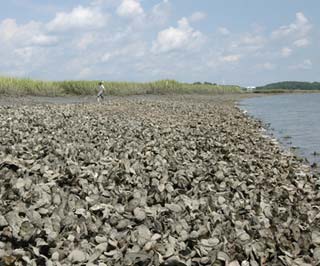Marine - Oyster Reefs
 Free swimming oyster larvae, called "spat," often attach to live oyster shell. This constant addition of new oysters on top of existing oysters can result in dense mounds of live animals and dead shell. These mounds, or oyster reefs, common in the intertidal areas of South Carolina estuaries, create vital habitat for many other species.
Free swimming oyster larvae, called "spat," often attach to live oyster shell. This constant addition of new oysters on top of existing oysters can result in dense mounds of live animals and dead shell. These mounds, or oyster reefs, common in the intertidal areas of South Carolina estuaries, create vital habitat for many other species.
Small invertebrates such as grass shrimp and juvenile brown and white shrimp along with larval blue crabs seek refuge from predators within the interstices of the reef structure. Stone crabs, both juveniles and adults, also inhabit oyster reefs.
Small fishes, including silversides and anchovies find shelter from predators and from strong tidal currents at oyster reefs. Many of these fishes feed extensively on the larval animals associated with reefs, before eventually becoming prey themselves to larger fishes. Oyster reefs are also used as a nursery habitat by many species, including flounder, black sea bass and Atlantic spadefish.
Permanent reef residents such as oyster toadfish, gobies and blennies attach their eggs to the undersides of oyster shell or within recently dead but still attached shells. Many other fish species (at least 35 documented), including species like spot and croaker, and larger predators such as red drum, spotted seatrout and sheepshead, come and go with the tide creating an entire food web based on oyster reefs.
These naturally occurring inshore reefs function much like man-made offshore artificial fishing reefs by providing habitat for many species, serving as orientation points for fish, and generating complex food webs.
Because oysters grow quickly, they can stay above the surrounding soft sediments that would bury other stationary organisms. So not only do these reefs offer ideal habitat for oyster spat, the resulting structure becomes a vital micro-environment within the state’s estuaries.
